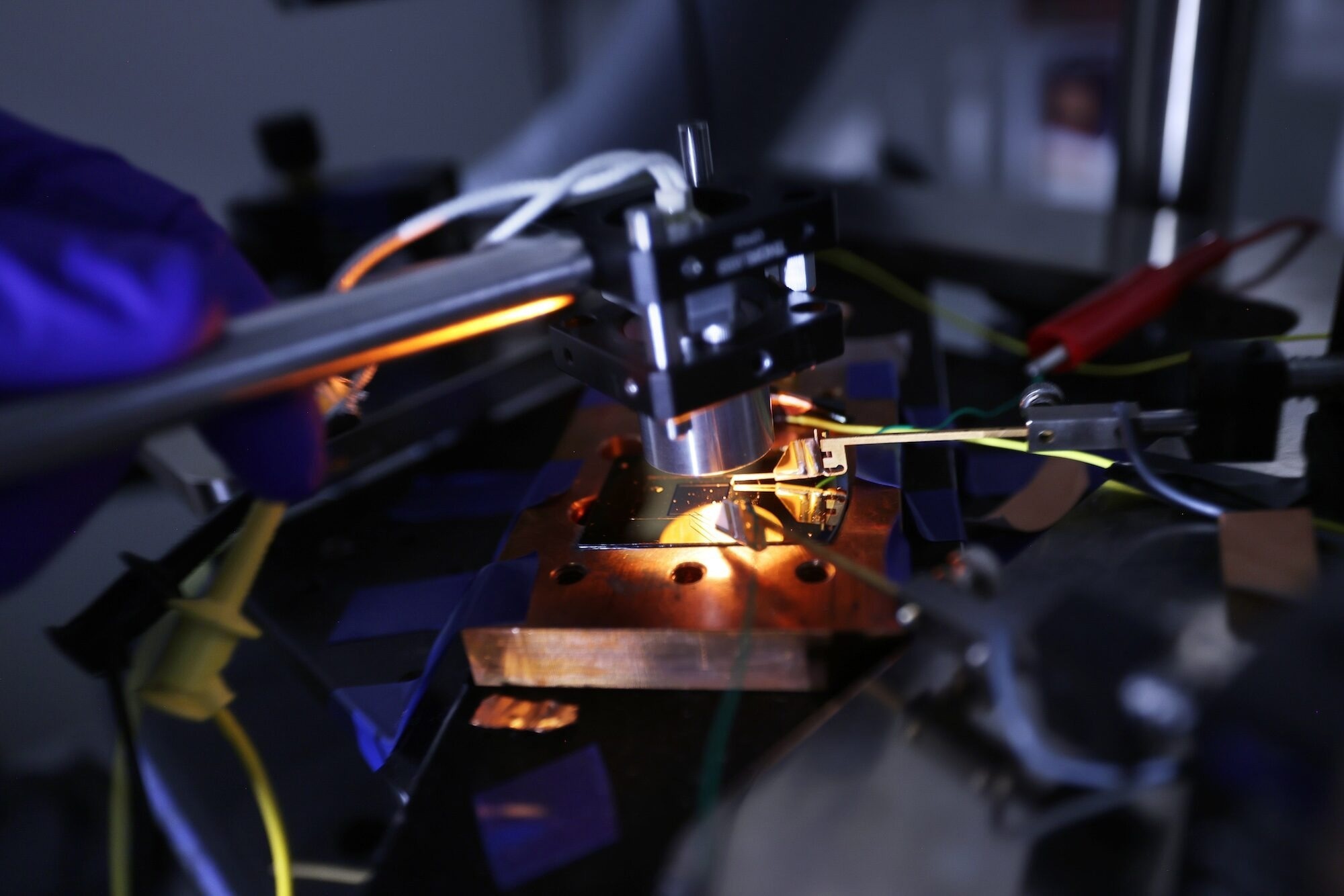According to a University of Michigan study spearheaded by researchers at the University of Michigan and published in Joule, devices that convert heat into electricity are getting closer to becoming viable for use on the grid.
 To measure the power produced by his photovoltaic cells, Roy-Layinde holds a heat source held over the photovoltaic cell, which emits the infrared radiation that the cell converts into electricity. Wires connected to the photovoltaic cell run the electricity to a sensor that reads the voltage and amperage. Image Credit: Brenda Ahearn, Michigan Engineering.
To measure the power produced by his photovoltaic cells, Roy-Layinde holds a heat source held over the photovoltaic cell, which emits the infrared radiation that the cell converts into electricity. Wires connected to the photovoltaic cell run the electricity to a sensor that reads the voltage and amperage. Image Credit: Brenda Ahearn, Michigan Engineering.
Heat batteries might store intermittent renewable energy during peak production hours and then transform it into electricity using a thermal version of solar cells.
As we include higher fractions of renewables on the grid to reach decarbonization goals, we need lower costs and longer durations of energy storage as the energy generated by solar and wind does not match when the energy is used.
Andrej Lenert, Study Corresponding Author and Associate Professor, University of Michigan
Thermophotovoltaic cells function similarly to photovoltaic cells (also known as solar cells). Both convert electromagnetic radiation into electricity. However, thermophotovoltaics utilize lower-energy infrared photons instead of the higher-energy photons in visible light.
The team states that their novel device has a power conversion efficiency of 44% at 1435 °C, which is within the target range for existing high-temperature energy storage (1200 °C-1600 °C). It outperforms earlier designs within this temperature range, which averaged 37%.
It is a form of battery, but one that is very passive. You don’t have to mine lithium as you do with electrochemical cells, which means you don’t have to compete with the electric vehicle market. Unlike pumped water for hydroelectric energy storage, you can put it anywhere and don’t need a water source nearby.
Stephen Forrest, Study Contributing Author and Peter A. Franken Distinguished University Professor, Electrical Engineering, University of Michigan
A heat battery would contain a block of heated material at a minimum temperature of 1000 °C encircled by thermophotovoltaics. That temperature might be attained by absorbing surplus heat from solar thermal energy, producing steel, glass, or concrete, or transferring electricity from a wind or solar farm via a resistor.
Lenert added, “Essentially, using electricity to heat something up is a very simple and inexpensive method to store energy relative to lithium ion batteries. It gives you access to many different materials to use as a storage medium for thermal batteries.”
The heated storage material emits thermal photons that have multiple energies. At 1435 °C, around 20-30% of those had enough energy to power the team’s thermophotovoltaic cells. The key to this study was adjusting the semiconductor material, which collects photons, to extend its preferred photon frequencies while remaining consistent with the dominating energy provided by the heat source.
However, the heat source generates photons with energy higher and lower than that which the semiconductor can convert to electricity. Without careful engineering, these would be lost.
To address this issue, the researchers incorporated a tiny layer of air into the thermophotovoltaic cell just beyond the semiconductor. They added a gold reflector, forming an air bridge beyond the air gap.
This cavity helped trap photons with the appropriate energies, allowing them to enter the semiconductor and return the remainder to the heat storage material, where the energy could be re-emitted as a photon that the semiconductor could collect.
Unlike solar cells, thermophotovoltaic cells can recuperate or recycle photons that are not useful.
Bosun Roy-Layinde, Study First Author and Doctoral Student, University of Michigan
Recent research discovered that stacking two air bridges enhances the design by improving the range of photons converted to electricity and the useful temperature range for heat batteries.
Forrest added, “We are not yet at the efficiency limit of this technology. I am confident that we will get higher than 44% and be pushing 50% in the not-too-distant future.”
Forrest is also the Paul G. Goebel Professor of Engineering and a professor of electrical engineering, computer science, materials science and engineering, and physics.
The team has filed for patent protection with the help of U-M Innovation Partnerships and is looking for partners to bring the technology to market.
This study was funded by the National Science Foundation (grant numbers 2018572 and 2144662) and the Army Research Office (grant number W911-NF-17-0312).
Journal References:
Roy-Layinde, B., et. al. (2024) High-efficiency air-bridge thermophotovoltaic cells. Joule. doi:10.1016/j.joule.2024.05.002.
Roy-Layinde, B., et. al. (2024) Integrated Air-Bridge Tandem Thermophotovoltaics with High Efficiency over a Broad Heat Source Temperature Range. ACS Energy Letters. doi:10.1021/acsenergylett.4c00774.